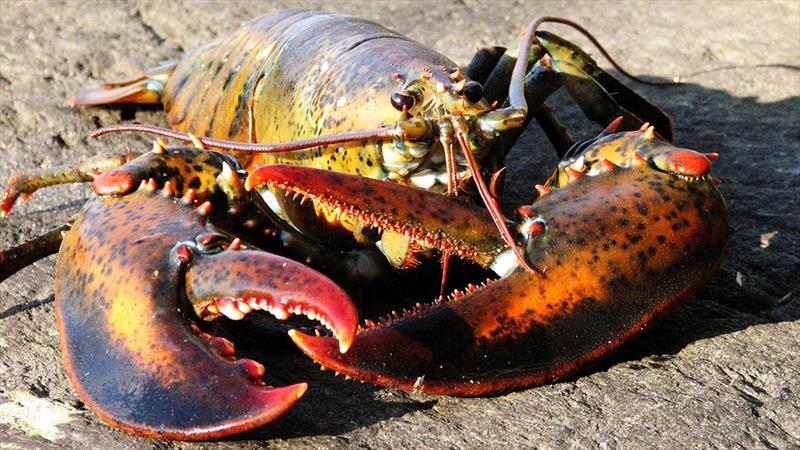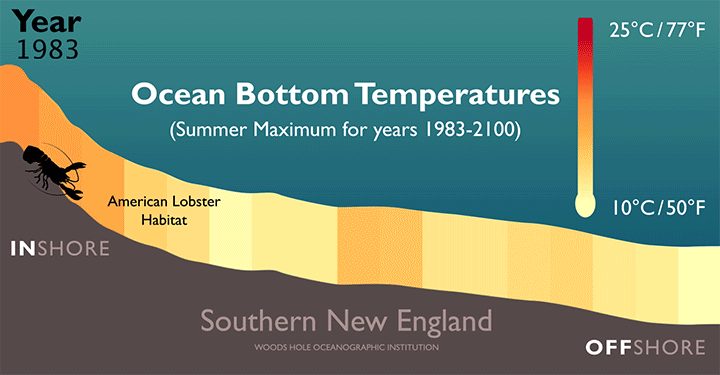
Feeling the heat in the NW Atlantic
by Woods Hole Oceanographic Institution 8 Feb 2018 17:50 UTC

The American lobster fishery—one of the most profitable, wild-caught fisheries—grossed more than $600 million in revenue in 2016. The fishery also employs thousands of people in the New England region © DejaVuDesigns / Shutterstock.com
Rising temperatures along the bottom of the Atlantic Ocean will force American lobsters (H. americanus) farther offshore and into more northern waters, according to a new study led by researchers at the Woods Hole Oceanographic Institution (WHOI).
Climate models project that bottom temperatures in the Atlantic along the U.S. East Coast may rise by up to 4.3 degreesC (7.7 degreesF) by the end of the century.
"That's a significant change, and lobsters are particularly sensitive to warming water temperatures," says WHOI researcher Jennie Rheuban, lead author of the paper published online last month in the Journal of Geophysical Research (JGR): Oceans. "The species experiences physiological stress across all life stages when temperatures rise above 20 degreesC (68 degreesF)."
Higher temperatures can affect lobster egg hatching and larval survival, Rheuban says. Females carry their eggs with them, and when the eggs hatch is largely determined by the temperature history the eggs have experienced.
Warming bottom temperatures can also reduce energy stores of overwintering invertebrates, such as lobster and copepods, and lead to more diseases, says coauthor Maria Kavanaugh, a former postdoctoral investigator at WHOI and now an assistant professor at Oregon State University.
The northeast U.S. continental shelf, which is home to a highly productive and commercially important marine ecosystem, has experienced some of the highest sea surface temperature warming rates in the world in recent decades.
"We wanted to find out specifically what was happening at the bottom, so that we could identify potential impacts to ecologically and commercially important species living there," says Rheuban. "We focused our analysis on the American lobster, but really the data could be used to look at impacts on other bottom-dwelling species, such as sea scallops."
Kavanaugh analyzed 33 years of historical ocean temperature data from the Northwest Atlantic Ocean, ranging from Cape Hatteras through the Gulf of Maine.
"Bottom temperatures have increased throughout the region, including the deeper Gulf of Maine," says Kavanaugh. The iconic crustaceans are currently found in waters from southern New England up to Canada, but regional warming is already causing a decline in lobster catch in southern New England.
The research team then coupled these historical data with future projections of ocean temperatures from climate models from Intergovernmental Panel on Climate Change (IPCC).
Climate models use math and statistical methods to simulate how interactions among the atmosphere, oceans, land surface, and ice drive Earth's climate. But large-scale climate models don't have high-enough resolution to capture complex small-scale variations that occur in near-shore environments, such as on the continental shelf. So Rheuban and her colleagues needed to "downscale" the models to make better predictions of ocean temperatures at local scales and look at their impacts on marine life.
The researchers downscaled projections from two different IPCC scenarios, based on possible future carbon dioxide emissions. One of the scenarios—known as the "business as usual" scenario—is based on unchecked emissions and taking no mitigating or policy action against climate change. The other scenario includes climate policy action and predicts roughly about half the warming as the other scenario.
In both cases, results showed that conditions in the southernmost range of the species—from Long Island Sound through Buzzards Bay, Ma.— will likely become less hospitable in the future for juveniles. The study also found that warming bottom temperatures may push lobsters farther offshore while the population will likely increase and expand northward in the Gulf of Maine.

Coastal environments act as a nursery habitat for both larvae and juveniles, providing them with a protective area that is food-rich and relatively safe from predators.
"If adult females are forced into deeper water because the temperatures are more ideal, larvae may hatch outside of the nursery habitat and be less likely to survive," says Rheuban. "Juveniles also may be forced into offshore waters that are less safe from predators."
The increased temperatures could also lead to more cases of epizootic shell disease, which is linked to warmer waters. The bacterial disease impacts the behavior, growth and mortality rates, reproductive success, and marketability of lobsters.
The American lobster fishery is one of the most profitable, wild-caught fisheries and grossed more than $600 million in revenue in 2016. The fishery also employs thousands of people in the region and leads to substantial regional economic benefits.
"Maintaining a healthy, sustainable fishery in southern New England into the future will be increasingly challenging with further climate change and ocean warming," says co-author Scott Doney, formerly of WHOI and now the Joe D. and Helen J. Kington Professor in Environmental Change at the University of Virginia. "An important next step, already under way, is to share our research findings with fishery managers and stakeholders from the northeast fishing community."
This work was supported by a grant from the John D. and Catherine T. MacArthur Foundation and a grant from NASA.
For more information, please visit www.whoi.edu.
This article has been provided by the courtesy of Woods Hole Oceanographic Institution.